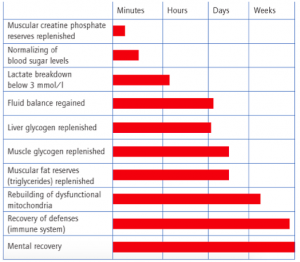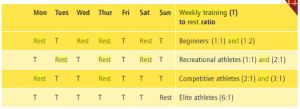Welcome to the important and often overlooked topic of recovery!
In part one, we’ll look at what recovery is and how different body systems deal with recovery.
In part two, we will look at some simple strategies you can use straight away to help you and your clients, recover.
Why am I writing this in two parts? Well – there are two reasons (how fitting)! First – I feel this is a subject that many times gets overlooked in our busy schedules. I mean seriously, who has the time to recover? There’s work to be done! Family to feed! Social media pages that require our attention! Don’t forget your high intensity workout! Secondly – as I started writing I got a little excited about the topic and I’ve created way too much content. 🙂
What is recovery? Yes, there are lots of different forms, but what is it? Recovery is described as, ‘A return to a normal state of health, mind, or strength’. That’s important! Let’s put that in terms of fitness. If exercise is a stress (good or bad), then our systems will want to return to their normal state – hormonally, structurally and mentally. Getting the balance between stress (exercise) and recovery right is what will bring about good adaptation.
Interestingly, there are other definitions of recovery. One I feel suits exercise (especially high intensity exercise) is ‘The action of taking a vehicle that has broken down or crashed, to a place for repair’. I know that after some of the HIIT sessions I have done, I have wanted to be taken to a place for repair!
A word on the word itself: how many times have you asked your clients (or yourself) to do some recovery in some form or another at the end of a session or before their next session? How many of your clients have actually done that ‘Homework’? Because there’s a word that inspires action – NOT! I mean, when you were at school, how much did you love homework?
If you’ve ever seen, been in or instructed a group fitness class, you may have noticed the mass exodus at the end of the class just as the ‘cool down’ track begins. It doesn’t matter that the instructor explained the importance of it. Nope – we have places to be, kids to pick up, coffee to drink! Perhaps we should look at changing the words recovery, homework and cool down. You can come up with your own, but terms we use at PTA are movement recovery or sometimes maybe more appropriate, movement preparation. By doing the right recovery, you are preparing your body for the next bout of movement.
What systems are affected by exercise? How long does it take different bodily systems to recover from exercise? Of course intensity and duration are the key here; the more intense the exercise the shorter the duration should be and the more rest you require (details on this can be found in the PTAG Bridging Course if you want to geek out). Usually, we prescribe rest between sets to give our clients a bit of a breather to replenish the stored energy they just used so they can perform again.
Here’s the thing…that bit of a breather is not the whole story. For example, part of what makes Trigger Point Performance products powerful is research that states that ’tissue that has trigger points showed minimal recovery within seven minutes whereas normal tissue (without trigger points) recovery of 70 – 90% within one minute’ (Headley, B. 1997). So if your client does a set of exercise on tissue that has ‘trigger points’, then 60 seconds is not enough recovery time, let alone 15 seconds. Not to mention the fact they’re probably at least a little dehydrated- one of the most powerful reasons for a rest between sets is to get some hydration to those working tissues.
In his book ‘Training with a Heart Rate Monitor’ , Kuno Hottenrott has the below table, titled ‘Regeneration time after intensive endurance loading’. Although in the title it says endurance, parallels could be drawn to all types of training. If you’ve ever done a heavy resistance session, you’ve felt that heart rate go up!
As you can see by the table it only takes minutes to replenish the creatine phosphate that may have been expended due to a bout of movement. In fact it should be fully replenished after three minutes. Muscle Glycogen, look at the difference – that will take several days. But the really powerful message from this table is putting a value on some of the systemic recovery that you may never have thought about! Fluid balance, rebuilding of dysfunctional mitochondria, the effect on the immune system and mental recovery! They can take a few weeks to fully recover!
The below table again from the above mentioned book, displays the suggested weekly sequence of training for different target groups.
The table clearly shows that the less ‘fit’ someone is, the more recovery they need. Now, what it doesn’t show is the intensity levels of the sessions conducted, especially those of the competitive or elite athlete.
In a research paper from the American College of Sports Medicine, titled ‘Autonomic Recovery after exercise in Trained Athletes: ‘Intensity and Duration Effects’, conducted in 2007, it states that: ‘elite athletes actually perform approximately 75% of their training at intensities clearly below their lactate threshold, relatively little training at the traditional lactate threshold and approximately 10 – 20% of their training at intensities clearly above the lactate threshold’. This clearly shows that athletes change the intensity of their sessions and that they actually spend a minimal amount of time at their best effort. Also, think about the amount of access professional athletes have to recovery. They have massage, sleep (which is probably now measured), hot and cold baths and usually measured nutritional / hydration intake. They are also starting to rely on Heart Rate Variability to indicate what training load an athlete should go through for that session.
Ok, ok, Chaddy, I get it! Recovery is important! What can I do about it? What strategies can I use to help my clients recover?
That’s the important question here isn’t it and – cliffhanger! – that’s exactly what we’ll cover in Recovery – Part 2.
Chaddy


